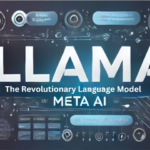In the rapidly evolving landscape of artificial intelligence, large language models (LLMs) have emerged as a transformative force. Among these, Llama, developed by Meta AI, has garnered significant attention for its impressive capabilities and versatility. In this blog post, we will delve into the world of Llama, exploring its features, applications, and the impact it has had on the AI community.
What is Llama?
Llama, short for Large Language Model Meta AI, is a family of autoregressive LLMs designed to process and generate human-like language. Initially released in February 2023, Llama has undergone significant updates, with the latest version, Llama 3.1, being released in July 2024. This cutting-edge model is trained on a massive dataset of text from various sources, enabling it to learn patterns, relationships, and context.
Key Features of Llama
Model Sizes
Llama models are available in various sizes, ranging from 7B to 405B parameters. This flexibility allows developers to choose the model that best suits their specific needs, balancing performance and computational resources.
Training Data
Llama’s training data consists of a massive corpus of text, which enables the model to learn about various topics, styles, and nuances of language. This extensive training data allows Llama to generate coherent and contextually relevant text.
Autoregressive Architecture
Llama’s autoregressive architecture enables the model to predict the next token in a sequence, given the context of the previous tokens. This architecture is particularly effective for tasks such as language translation, text summarization, and text generation.
Applications of Llama
Llama’s capabilities have been leveraged in various applications, including:
Language Translation
Llama’s language translation capabilities have been demonstrated to be on par with state-of-the-art models. Its ability to learn from large datasets and generate coherent text makes it an attractive choice for translation tasks.
Text Summarization
Llama’s text summarization capabilities enable it to condense long pieces of text into concise, informative summaries. This feature has been used in various applications, including news aggregation and content recommendation.
Text Generation
Llama’s text generation capabilities have been used in various creative applications, including writing articles, generating chatbot responses, and even creating entire books.
Impact of Llama on the AI Community
Llama’s release has had a significant impact on the AI community, with many researchers and developers leveraging its capabilities for various applications. The model’s flexibility, performance, and ease of use have made it a popular choice among AI enthusiasts.
Open-Source Release
Llama’s open-source release has enabled developers to access the model’s code, modify it, and distribute it freely. This move has fostered a sense of community, with many developers contributing to the model’s development and improvement.
Commercial Applications
Llama’s commercial applications have been explored by various companies, including Meta, which has used the model to improve its chatbot and content recommendation systems.
Challenges and Limitations
While Llama has demonstrated impressive capabilities, it is not without its challenges and limitations. Some of the key limitations include:
Compute Power
Llama’s training requires significant computational resources, which can be a barrier for developers with limited access to powerful hardware.
Bias and Fairness
Llama’s training data may contain biases and inaccuracies, which can be reflected in the model’s outputs. Ensuring fairness and mitigating bias in Llama’s outputs is an ongoing challenge.
Conclusion
Llama has emerged as a powerful tool in the AI landscape, offering impressive capabilities and versatility. Its applications in language translation, text summarization, and text generation have demonstrated its potential to transform various industries. While challenges and limitations exist, the AI community’s efforts to improve and expand Llama’s capabilities will undoubtedly lead to further innovations and breakthroughs.
References
Graphs and Images
Note: The graphs and images used in this blog post are for illustrative purposes only and may not reflect the actual performance or architecture of Llama.

